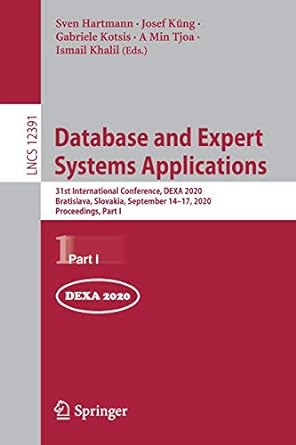Question
Take the followng code in verilog syntax and write it with vhdl syntax module lab5b(input SIG,CLOCK_50,output [6:0] HEX3,HEX2,HEX1,HEX0); reg l_flg; // this is a flag
Take the followng code in verilog syntax and write it with vhdl syntax
module lab5b(input SIG,CLOCK_50,output [6:0] HEX3,HEX2,HEX1,HEX0);
reg l_flg; // this is a flag that may be used in your behavioral
// design to allow a count value to be latched and
// cleared when SIG=1
reg [10:0] count; // cap 0.01 uf discharge time count
reg [15:0] bcdout; // bcd representation of cap value count
reg sig; // debounced version of input SIG
initial
begin
l_flg=0;
count=0;
end
// 50 Mhz is very fast compared to the rise and fall times
// of the 555 output so a simple one stage debounce may
// be useful to stop miss readings -- this debounce
// sections requires SIG to be constant for at least two
// consecutive 50 Mhz clock cycles before the debounced
// version of SIG (i.e. named sig) is allowed to transition
always @ (posedge CLOCK_50)
begin:SIG_debounce
reg last_sig;
if (sig)
begin
if (!SIG & !last_sig) sig=0;
end
else
begin
if (SIG & last_sig) sig=1;
end
last_sig = SIG;
end
// ENTER YOUR MODELLING CODE HERE!!!
// may want to use the bintobcd function
// on the rising edge of your main clock, CLOCK_50,
// Do the following using an always @ procedural statement:
always @(posedge CLOCK_50)
begin
// measure the number of 0.01 uf time periods when sig=0
if (!sig)
begin
// check to see if the 0.01 uf cap discharge time counter is
// that is driven by the 50 Mhz clock is less than the
// maximum count value -- if this is the case increment
// the value by one
if (count<1771) // Manually entered, Bero
count = count + 1;
else
begin
// if the 0.01 uf cap discharge time counter has reached its
// max allowed value check to see if the SIG input is low
// if it is then that means we should reset the 0.01 uf
// count value to 0 to start a new count cycle
// reset the 0.01 uf discharge time counter
if (!SIG)
count = 0;
// increment BCD cap value count by 1. Do this only
// if cap value count has not reached the 9999 max. This will
// stop wrap around for capacitors that have capacitances that
// are out of range.
// You should in effect enter code that will increment
// in BCD the count value by 1
bcdout = bcdout + 1;
if (bcdout[3:0] > 9)
begin
bcdout[3:0] = 0;
bcdout[7:4] = bcdout[7:4] + 1;
end
if (bcdout[7:4] > 9)
begin
bcdout[7:4] = 0;
bcdout[11:8] = bcdout[11:8] + 1;
end
if (bcdout[11:8] > 9)
begin
bcdout[11:8] = 0;
bcdout[15:12] = bcdout[15:12] + 1;
end
if (bcdout[15:12] > 9)
begin
bcdout[15:12] = 0;
end
// Set the l_flg to enable first pass latching of display
// variables and the clearing of binary count the next time
// SIG is equal to a logic 1
l_flg = 1;
end
end
// On the first clock cycle that sig=1 convert and latch the output
// data taken during the time sig=0, clear the binary cap value count
// and initialize the 0.01 uf time counter to its midrange value
else
begin
// when l_flg is true it is the first 50 Mhz clock cycle that
// sig = 1
if (l_flg)
begin
// drive the appropriate seven segment dispaly (use
// the bintohex task)
bintohex(bcdout[15:12], HEX3);
bintohex(bcdout[11:8], HEX2);
bintohex(bcdout[7:4], HEX1);
bintohex(bcdout[3:0], HEX0);
// clear the capacitance BCD count value
bcdout = 0;
count = 0;
// set the 0.01 uf capacitance counter to the midrange
// value to allow it to be offset by one half of its
// maximum value -- this allows it to round up values
// at the least sigificant position
// reset the l_flg to false -- this allows only one
// pass through this outputing and reseting phase
l_flg = 0;
end
end
end
// binary to 7-seg hexadecimal output task
task bintohex (input [3:0] bin_num, output [6:0] hex_num);
case (bin_num)
0 : hex_num <= 7'b1000000;
1 : hex_num <= 7'b1111001;
2 : hex_num <= 7'b0100100;
3 : hex_num <= 7'b0110000;
4 : hex_num <= 7'b0011001;
5 : hex_num <= 7'b0010010;
6 : hex_num <= 7'b0000010;
7 : hex_num <= 7'b1111000;
8 : hex_num <= 7'b0000000;
9 : hex_num <= 7'b0011000;
10 : hex_num <= 7'b0001000;
11 : hex_num <= 7'b0000011;
12 : hex_num <= 7'b1000110;
13 : hex_num <= 7'b0100001;
14 : hex_num <= 7'b0000110;
15 : hex_num <= 7'b0001110;
default : hex_num <= 7'bx;
endcase
endtask
endmodule
Step by Step Solution
There are 3 Steps involved in it
Step: 1

Get Instant Access to Expert-Tailored Solutions
See step-by-step solutions with expert insights and AI powered tools for academic success
Step: 2

Step: 3

Ace Your Homework with AI
Get the answers you need in no time with our AI-driven, step-by-step assistance
Get Started


